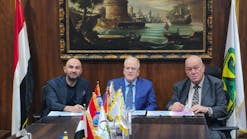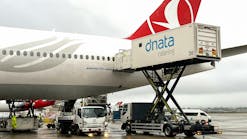Preparing the Ground - How People Behind the Scenes Keep an Airport Operational
At a commercial airport, the term ground crew covers a multitude of jobs which are all essential in keeping it ticking over. From gate coordinator to toilet effluent tank extractor, each one helps to ensure that your plane takes off with everything it needs to complete its flight safely. Here, we investigate the vital work people do in eight of these jobs, and flag up their often unsung contribution to airport life.
Gate Coordinator
This is an extremely responsible job; gate coordinators are the primary ground link with the aircraft pilot and crew. They oversee the safe and punctual turnaround of the aircraft, the embarkation and disembarkation of passengers, the positioning of the airbridge and the adherence to all operating and health and safety procedures during the process. Paperwork relating to the aircraft turnaround has to be completed, including the weight and balance documentation, load sheet and fuel load, and if there’s a delay to take-off or a safety incident while they are in charge then a detailed report has to be submitted.
Aircraft Marshaller
Once a plane has landed, it’s the job of an aircraft marshaller to direct it to the gate safely. Pilots in a large aircraft have limited visibility, especially for anything on the ground below the cockpit. This means they have to rely on the marshal to prevent collisions, such as with other aircraft wings, and to ensure the ground is clear of obstacles. A marshaller holds two illuminated batons, which are used to signal to the pilot. Any movements made by the marshal have to be assertive and positive directions to avoid confusion. Signals include turn left/right, chocks inserted, move back, connect, proceed, all clear, disconnect to ground power and emergency stop.
Ramp Agent
A ramp agent is responsible for the under-wing services for an aircraft, such as parking, cabin maintenance services, loading and unloading luggage and cargo. They will ensure chocks are placed under the wheels and safety cones placed round the aircraft once it’s parked. Ramp agents work in teams, usually made up of four people, and will operate ground equipment such as freight carts for luggage, forklifts and belt loaders. An important duty is to make sure the luggage is loaded onto the correct aircraft. It’s a very physical job, involving heavy lifting and working outside in all weathers and temperatures.
Aircraft Refueller
An aircraft refueller will monitor fuel levels in aircraft during refuelling and assess and perform maintenance on fuel systems and components such as hoses, gauges, valves, pumps and filters. Refuelling takes place after passengers have disembarked and before the next group boards to comply with safety regulations. You may have wondered where fuel tanks are located in a commercial aircraft full of passengers and baggage. While many people might assume they are located underneath or towards the back of the plane, they are in fact across the width of the wings. The standard speed at which an aircraft is refuelled is 1,000 liters per minute, although for a wide-bodied aircraft this can be doubled if two hoses are used at once. Fuel is calculated carefully based on the fuel consumption of the aircraft and the time it should take to fly to its destination, with additional fuel reserves in case of diversions or delays.
Airport Rescue and Firefighting
A critical part of any airport team is the rescue and firefighting service. It’s known in the UK as the RFFS (Rescue and Firefighting Services) to distinguish it from the FRS, which is the local authority fire and rescue service (FRS). Members must be ready to respond instantly to any scenario, both on the airfield and in the terminals. Incidents include fires, collisions, traffic accidents on airport property and spills of hazardous chemicals, as well as conducting regular testing of all fire alarms and other safety equipment across the airport and ensuring a safe environment around refuelling and chemical storage. Where an airport is near to a large body of water, crews must also be trained to operate a water rescue service.
Toilet Effluent Tank Extractor
Another extremely important job, but not one that comes instantly to mind is that of the toilet effluent tank extractor. A vacuum flush system was invented in 1975 and was initially trialed in 1982 in a Boeing aircraft. During a flight, waste and Skykem - the blue liquid which is used to disinfect the bowl after use - is stored on board in a waste-holding tank. On landing, a toilet effluent tank extractor connects a special effluent tank truck to the aircraft tank with a hose and vacuums the waste off the plane. The on-board tanks are cleaned and disinfected after each flight.
Foreign Object Debris (FOD) Remover
While a large object on the runway is clearly a danger to an incoming plane, small objects can also cause a great deal of safety problems. Stray nuts and bolts, pebbles, broken glass and even pens can cause serious incidents, such as a damaged tire. Additionally, when a plane takes off, it draws in colossal amounts of air. Any detritus lying around, even small items of litter, could end up being sucked into an engine, causing extensive impairment, or be blown a considerable distance at high velocity with the potential to cause a major injury.
FOD removers will patrol runways in special vehicles to scan for potential hazards. These include vacuum sweepers, magnetic sweepers and regenerative air sweepers on which air vents move FOD into a suction area for collection. Larger airports have FOD detection systems which continuously scan runways from strategically placed cameras. These systems can also monitor the condition of the runway surface. It’s not just debris which needs removing – according to the operator at Schiphol Airport, just one aircraft landing leaves behind 22 pounds of rubber from the tires, which will need to be regularly cleaned off to prevent a plane from losing traction on the runway.
Aircraft Cleaner
When passengers board a plane, they'll hopefully find seats looking clean and tidy, with the tray wiped down and its previous occupant’s sweet wrappers, magazines and water bottles removed. Aircraft cleaners work to a tight timetable between turnarounds, cleaning walls, floors, seats, toilet areas and windows. They will wipe up spillages, replace light bulbs, empty bins and undertake necessary minor repairs, making sure the plane is hygienic and ready for take-off. They also come across some very strange items left behind by passengers – these have included a parrot, a single egg, numerous glass eyes and prosthetic legs, a crocodile head and a unicycle.
Behind the scenes there’s a legion of people working tirelessly to keep everything on schedule, and without all these workers, passengers would never get off the ground.




